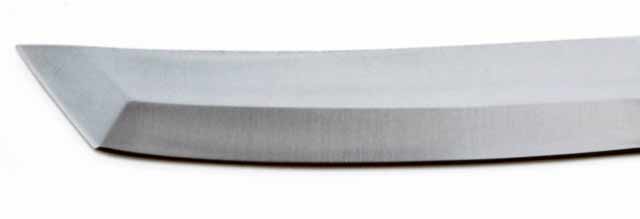The Tanto Blade: When Ancient Japanese Warriors Had the Right Idea About Pointy Things
Meet the tanto blade – This isn’t just sharp metal with commitment issues; it’s a masterclass in “how to make something both beautiful and terrifyingly effective.”
A Brief History Lesson (Don’t Worry, No Pop Quiz)
Picture this: It’s 800 AD, and Japanese samurai have come up with an idea so bright that if it were a cartoon, a little light bulb would appear over their heads. Scratch that, it’s ancient Japan, so swap out the light bulb for some kinda ricepaper lantern. The idea was to create a knife that means business but doesn’t take up too much real estate on a belt.
Thus, the tanto was born – originally as the samurai’s trusty sidekick. By the Kamakura period (1185-1333 AD), these little warriors had earned quite the reputation. Think of them as the Swiss Army knife’s intimidating older brother who went to military school and never let anyone forget it.
The tanto wasn’t just riding solo either. It completed the legendary daisho set alongside the katana and wakizashi – basically the samurai equivalent of a perfectly coordinated outfit, except deadlier and with more historical significance.
Design Features
The tanto sports a straight or slightly curved edge with a tip so sharp it could probably cut through your weekend plans. At 5-10 inches long, it’s the Goldilocks of blades – not too long, not too short, but just right for both precision work and “please step away from my rice field” situations. The blade is often forged with a thick spine, especially American versions, providing durability and strength.
The tip of the tanto blade is particularly notable for its reinforced point, which allows it to penetrate tough materials without breaking. This design also makes the tanto ideal for thrusting attacks.

Uses of the Tanto Blade
Combat
Historically, the tanto was a weapon of choice for close-quarters “negotiations”. Its compact size made it easy to carry and conceal, allowing samurai to use it in situations where longer swords were impractical.
Utility Tool
Beyond its warrior credentials, the tanto moonlighted as the ultimate utility player. Rope cutting, food prep, crafting projects – this blade handled daily life with the same enthusiasm it brought to battle.
Modern-Day Relevance
Fast-forward to today, and the tanto has successfully reinvented itself for the tactical and survival crowd. Military personnel, law enforcement, and outdoor enthusiasts have collectively said, “You know what? Those samurai were on to something.” It’s like the blade went to business school and emerged with an MBA in Modern Practicality.
Collecting and Martial Arts
Tantos have also captured the hearts of collectors and martial arts practitioners who appreciate both craftsmanship and the art of “looking incredibly cool while practicing ancient techniques.” It’s history you can hold, tradition you can train with, and art that happens to be exceptionally good at cutting things.
The Bottom Line
The tanto blade isn’t just a knife – it’s a 1,000-year success story that refuses to retire. From feudal Japanese battlefields to modern tactical operations, it’s proven that sometimes the best ideas are the ones that stick around long enough to become legends.
Whether you’re a collector, a practitioner, or someone who simply appreciates when form meets function and they decide to dance together beautifully, the tanto represents something special: timeless design that works as brilliantly today as it did when samurai first decided that sometimes, you need a blade that’s both elegant and absolutely no-nonsense.
Because at the end of the day, the best tools are the ones that have been battle tested by centuries of people who really, really needed them to work.
